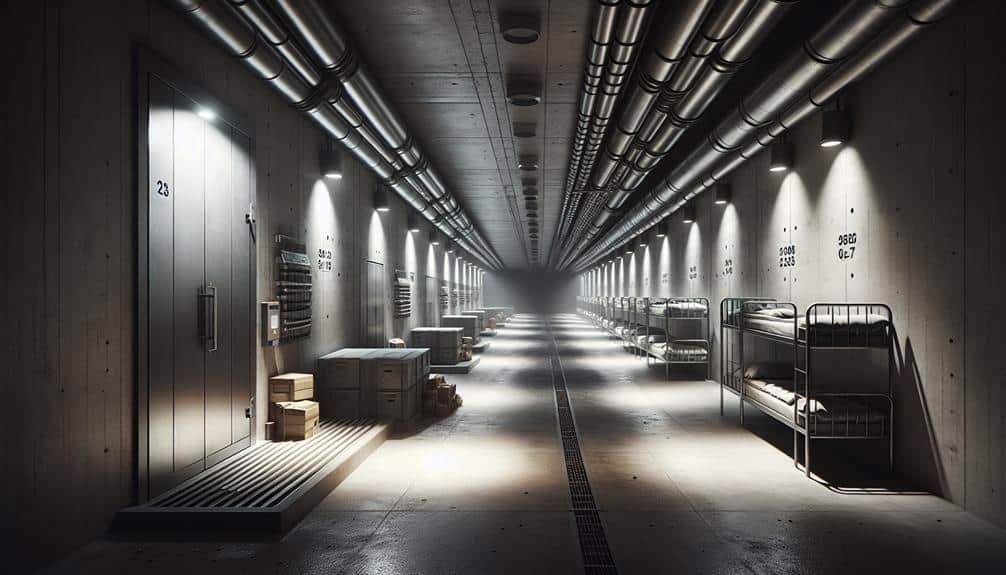We identify several safe underground storm shelter options across various sectors. For residential properties, reinforced concrete shelters installed with appropriate drainage systems are ideal. Community shelters, often in church basements or park locations, provide scalable solutions for neighborhoods. In commercial properties, structural strength and capacity planning are paramount for industrial bunkers. Schools and campuses integrate underground shelters complying with safety protocols and equipped with emergency supplies. Public utility shelters guarantee critical equipment and personnel protection, focusing on strategic location, structural strength, and extensive ventilation and communication systems. Each option addresses specific needs and challenges, which we can explore further.
Key Points
- Residential underground shelters provide personalized protection with reinforced concrete and drainage systems.
- Community shelters include neighborhood storm shelters and church basements engineered for safety.
- Industrial bunkers in commercial properties ensure structural integrity and secure, ventilated spaces.
- Schools and campuses integrate underground shelters with emergency supplies and communication plans.
Residential Underground Shelters
When evaluating the safety and feasibility of residential underground shelters, we must consider factors such as soil composition, water table levels, and structural integrity. These elements are vital to ensuring home safety and effective subterranean protection during severe weather events.
First, soil composition directly impacts the shelter's durability. Sandy soils might lack sufficient support, leading to structural compromises, while clay-heavy soils could cause water retention issues. Conducting a thorough geotechnical survey helps us identify the ideal soil conditions for constructing a reliable underground shelter.
Next, water table levels are essential in preventing flooding. High water tables can lead to water intrusion, compromising the shelter's integrity and safety. Installing proper drainage systems and utilizing waterproof materials can mitigate these risks, ensuring the shelter remains dry and functional.
Lastly, structural integrity is paramount. Reinforced concrete is often the preferred material due to its strength and durability. The shelter's design must also adhere to local building codes, ensuring it can withstand external pressures from soil and potential seismic activity.
Community Shelter Options
While residential shelters offer personalized protection, community shelter options provide a scalable solution for safeguarding larger populations during severe weather events. Evaluating community center options and park shelter locations is essential for effective disaster preparedness. These shelters are strategically located to guarantee accessibility for a significant number of residents, providing a collective safety net.
Neighborhood storm shelters are often integrated within existing community centers, offering a readily available refuge. These facilities are typically reinforced with strong materials to withstand extreme weather conditions. Utilizing these communal spaces maximizes resources and minimizes individual costs, enhancing overall community resilience.
Church basement options present another viable alternative for community storm shelters. Many churches have extensive, reinforced basements that can accommodate numerous individuals during emergencies. These spaces are often well-maintained and centrally located, making them convenient for rapid evacuation scenarios.
Park shelter locations can also serve as effective storm shelters, provided they're engineered with subterranean safety in mind. These shelters offer the dual benefit of being situated in open areas, reducing congestion and facilitating easier access.
Commercial Property Solutions
Commercial properties offer robust storm shelter solutions that can greatly enhance community safety during severe weather events. By integrating industrial bunkers and corporate hideaways into commercial infrastructure, we can provide reliable protection against tornadoes, hurricanes, and other severe meteorological phenomena.
The following considerations are essential for deploying storm shelters in commercial properties:
- Structural Integrity: Guaranteeing that industrial bunkers are constructed with high-grade materials to withstand extreme weather conditions.
- Capacity Planning: Designing shelters with adequate space to accommodate employees, clients, and visitors during emergencies.
- Access Control: Implementing secure entry systems to prevent unauthorized access and maintain order during evacuation procedures.
- Ventilation Systems: Equipping corporate hideaways with advanced air filtration and ventilation systems to secure breathable air and prevent overheating.
School and Campus Shelters
To safeguard the safety of students and staff during severe weather events, implementing well-designed storm shelters within school and campus environments is paramount. We need to focus on integrating underground options that align with robust safety protocols. These shelters must be equipped with necessary emergency supplies, including first-aid kits, non-perishable food, water, and communication devices.
Strategically planning evacuation routes is critical. These routes should be clearly marked and regularly practiced through drills to make certain everyone knows the fastest, safest path to the shelter. The communication plans we develop must include multiple channels, such as public address systems, text alerts, and social media updates, to ensure timely information dissemination to all campus occupants.
By incorporating detailed safety protocols, we can create a secure environment that allows for quick, efficient response during emergencies. It's vital to involve all stakeholders, including administrators, teachers, and security personnel, in the planning and execution phases to ensure a thorough approach.
Ultimately, the goal is to provide a safe haven that upholds the freedom and well-being of our academic communities, safeguarding them against the unpredictability of severe weather.
Public Utility Shelters

As we address the need for secure storm shelters within educational institutions, we must also consider the essential role of public utility shelters in maintaining the safety and functionality of essential infrastructure during severe weather events.
Public utility shelters are crucial for safeguarding the operational integrity of utilities such as water, electricity, and telecommunications. These shelters protect critical equipment and personnel, ensuring services remain uninterrupted during storms.
Public utility shelters can be strategically located underground, offering robust protection against high winds and debris. Utilizing underground park shelters and outdoor shelters designed for public utilities allows us to shield essential infrastructure efficiently.
Key considerations for public utility shelters include:
- Location Proximity: Shelters should be near critical utility sites for quick access.
- Structural Integrity: Must withstand extreme environmental conditions to protect equipment and personnel.
- Ventilation and Access: Ensuring adequate airflow and safe entry/exit during emergencies.
- Capacity Requirements: Sufficient space to accommodate essential personnel and equipment.
Frequently Asked Questions
What Are the Maintenance Requirements for Underground Storm Shelters?
Let's hit the nail on the head: regular inspection of seals, proper ventilation, and rust prevention are key maintenance tips. After the installation process, verify drainage systems are clear and conduct bi-annual checks for peak safety.
How Do Underground Shelters Compare in Cost to Above-Ground Options?
In our cost comparison, underground shelters often have higher initial costs due to design considerations and the installation process. However, their long-term durability can be superior, potentially offering savings over time compared to above-ground options.
Are There Specific Ventilation Needs for Underground Shelters?
We must consider ventilation requirements and safety regulations for underground shelters. Proper construction materials and location preferences are essential to guarantee air quality and occupant safety, meeting all necessary standards. Let's prioritize our freedom and well-being.
Can Underground Shelters Be Customized for Specific Climate Conditions?
Isn't it ironic that we can personalize underground shelters for any climate conditions? Customization options abound; we can adjust insulation, ventilation, and moisture control. With precise climate considerations, we guarantee our freedom and comfort underground.
What Are the Safety Protocols for Using Underground Shelters During an Emergency?
For safety protocols in underground shelters during emergencies, we must follow strict emergency procedures and confirm ventilation systems are fully operational. This guarantees our freedom to remain safe and breathe easily while awaiting the all-clear signal.


